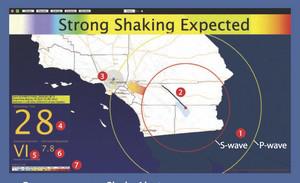EarthquakesL.A. showcases quake alert system
California is earthquake country, and residents of Los Angeles can now get some critical warning, when conditions are right, after a quake has started and seismic waves are heading their way. The long-delayed system, called ShakeAlertLA, is the first of its kind in the United States.

ShakeAlert gives the public a chance to get to cover. // Source: wikipedia.org
California is earthquake country, and residents of Los Angeles can now get some critical warning, when conditions are right, after a quake has started and seismic waves are heading their way. The long-delayed system, called ShakeAlertLA, is the first of its kind in the United States. Earthquake alert systems like this save lives, said Jeff Gorell, deputy Los Angeles mayor for public safety, as he demonstrated the application on his smartphone.
“When an earthquake starts, the first waves that go out are called P-waves,” he said. They serve as a warning and “are not the damaging, destructive waves” that will follow.
The alert system, which relies on data from seismic sensors throughout the region, could offer up to 90 seconds of warning for quakes of magnitude 5 or larger.
Even a few seconds can make a difference, said Los Angeles Mayor Eric Garcetti, as he rolled out the ShakeAlertLA smartphone app in January. Alerts let people know to drop, cover and hold on, as they are instructed to do in earthquakes.
Mexico City system
An alert system is in place in Mexico City that let residents brace for a mild shaker in early February after an earthquake struck Chiapas to the south. The quake was barely felt in the capital, but residents were ready.
The system doesn’t always help, however, and it did not with the magnitude 7.1 earthquake on Sept. 19, 2017, that killed hundreds in and around the Mexican capital. The quake’s epicenter was too close to offer warning.
Distance to epicenter crucial
Alert systems work when there’s enough distance between the earthquake’s epicenter and a center of population, said Thomas Heaton, professor of engineering seismology at the California Institute of Technology (Caltech).
“So, if you can recognize that an earthquake has started … you can give some area that’s about to be shaken strongly a heads up that says, ‘There’s an ongoing earthquake, and oh, by the way, it’s headed in your direction.’”
